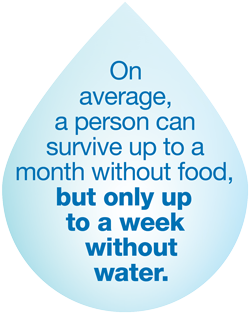 |
Water Conservation

On this page:
KITCHEN
- When washing dishes by hand, don't let the water run. Fill one basin or a large pot with wash water and the other with rinse water.
- Dishwashers typically use less water than washing dishes by hand. ENERGY STAR® dishwashers save even more water and energy.
- If your dishwasher is new, cut back on rinsing. Newer models may not require any rinsing.
- Designate one glass for your day's drinking needs or fill a water bottle. This will cut down on the number of glasses to wash.
- Soak pots and pans instead of letting the water run while you scrape them clean.
- Compost fruit and vegetable scraps rather than using the garbage disposal.
- Wash your fruits and vegetables in a pan or pot of water instead of running water from the tap. Then, use that water for your plants.
- Defrost food in the refrigerator for water efficiency and food safety rather than thawing food under running water.
- Keep a pitcher of drinking water in the refrigerator rather than running the tap to get cold water. This way, every drop goes down you and not the drain.
- Reuse leftover water from cooked or steamed foods to start a nutritious soup.
- Cook food in as little water as possible. This also helps food retain more nutrients.
- Select the proper pan size for cooking. Large pans may require more cooking water than necessary.
- If you accidentally drop ice cubes, don't throw them in the sink. Drop them in a house plant or your pet's water bowl instead.
- When shopping for a new dishwasher, compare water usage between models and consider ENERGY STAR® or WaterSense labelled models.


LAUNDRY ROOM
- When doing laundry, match the water level to the size of the load.
- Washing clothes in cold water saves water and energy, and helps your clothes retain their colour.
- When shopping for a new washing machine, consider comparing water usage between models and always consider ENERGY STAR® or WaterSense labelled models.
- Have a plumber re-route your greywater to trees and plants rather than the sewer line.

BATHROOM
- If your shower fills a four litre (one gallon) bucket in less than 20 seconds, replace the showerhead with a WaterSense® or ENERGY STAR labeled model.
- Shorten your shower by a minute or two and you'll save up to 565 litres (149 gallons) per month.
- Time your shower to keep it under five minutes. You'll save up to 3,785 litres (1,000 gallons) per month.
- Toilet leaks can be silent! Be sure to test your toilet for leaks at least once a year. Put food coloring in your toilet tank. If it seeps into the bowl without flushing, there's a leak. Fix it and start saving water and money.
- When running a bath, plug the bathtub before turning on the water. Adjust the temperature as the tub fills.
- If your toilet flapper doesn't close properly after flushing, replace it. (Check out the Do It Yourself section for step by step instructions.)
- Turn off the water while you brush your teeth and save up to 15 litres (four gallons) a minute. That's up to 757 litres (200 gallons) a week for a family of four.
- Shopping for a new toilet? Consider buying a dual-flush toilet. It has two flush options: a half-flush for liquid waste and a full-flush for solid waste. Look for water-saving WaterSense® or ENERGY STAR labeled models.
- Plug the sink instead of running the water to rinse your razor and save up to 1,136 litres (300 gallons) of water a month.
- When washing your hands, turn the water off while you lather.
- Take five minute showers instead of baths. A full bathtub requires up to 265 litres (70 gallons) of water.
- Install water-saving aerators on all of your faucets.
- Drop tissues in the trash instead of flushing them and save water every time.
- One drip every second adds up to 19 litres (five gallons) per day! Check your faucets and showerheads for leaks.
- While you wait for hot water, collect the running water and use it to water plants.
